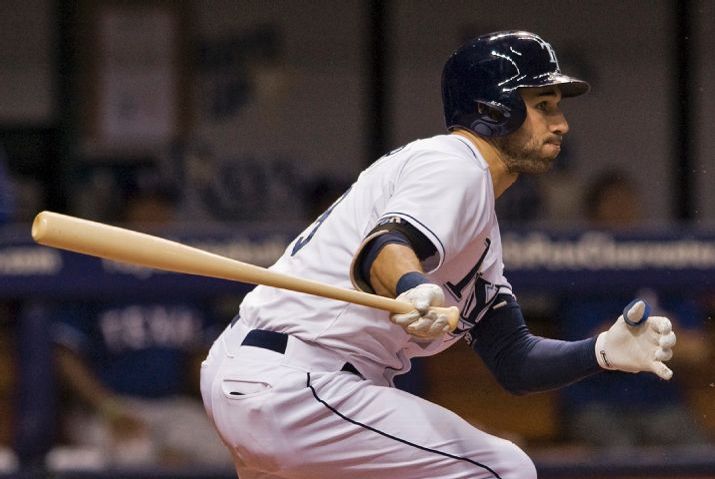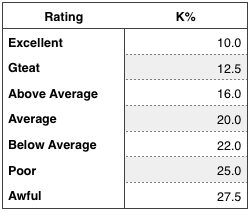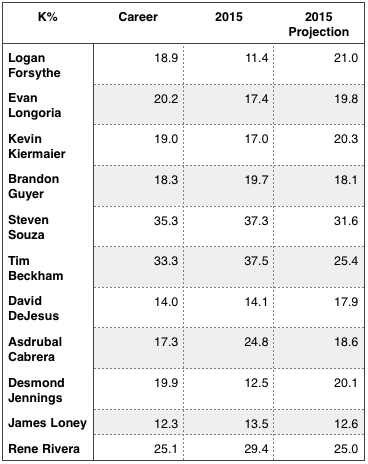
Allow me to expand on things.
Strikeout percentage is a statistic based on total plate appearances. It can be used to make inferences about a player based on a certain sample size — in this case 60 plate appearances, when strikeout percentage tends to stabilize. To put things in perspective, beyond the watermark of 60 plate appearances, it is unlikely that a player’s strikeout percentage is based solely on random variation.
It is, typically, the first statistic to be analyzed because of the incredibly small sample size needed to accrue information. Walk percentage follows, stabilizing at 120 plate appearances, while HR rate stabilizes at 170 plate appearances — so on and so forth. You can read an excellent article on statistics and sample size at Baseball Prospectus.
The question begs, how are the everyday players on the Rays’ roster looking so far? Let’s take a look.


The Good — Logan Forsythe, Evan Longoria, Kevin Kiermaier, David DeJesus.
Aside from the acquisition of Brad Boxberger, Forsythe is showing why he too was an integral part of the deal involving Alex Torres. His walk rate is down, his batting average and BABIP are up, and his strikeout numbers are down. There’s not much to be disappointed in at the moment.
Despite what the seeing eye test on Longoria might suggest, he is actually performing better than he has in every single season, with the exception of 2011. Though his RBI count is down, there are a lot of non-Longo factors why — lineup construct being one.
Kiermaier’s strikeout percentage is especially encouraging since he’s posted a lower rate while facing a LHP 30% of the time (vs. LHP 22% of the last season).
As Ian Malinowski (DRaysBay) wrote of DDJ, his “power is slightly lower for DDJ than it’s been in the past, and his walks are down compared to recent years, but those are still pretty noisy statistics in his small sample size. Judging by strikeout rate, DeJesus at age 35 is still the same hitter he was for 273 plate appearances at age 34, and it’s a damn good thing the Rays didn’t trade him during the offseason.”
The Bad — Steven Souza Jr., Asdrubal Cabrera, Brandon Guyer, Rene Rivera.
To put it bluntly, opposing pitchers are exposing the holes in Souza’s swing. The rookie earned 37.3% K% by not protecting a large enough zone, and getting fooled badly in the times he does. He has shown the ability to learn and make adjustments. Here’s to hope he can continue to do that and lower that gaudy number.
Cabrera was the big free-agent acquisition that Matt Silverman hung his hopes on. Unfortunately he hasn’t been the most productive player in the lineup. He’s striking out at a higher clip than ever before, and it isn’t uncommon to see him pop out into the more shallow parts of the field when he does make contact. This friends, isn’t good.
Guyer’s 1.4% increase is negligible, especially over the small sample size. I’m not overly concerned.
Beckham has shown what he can do when he makes good contact; his five extra base hits, nine runs, and 11 RBI in just 62 at-bats speak to that. However, he’s also been pretty over matched on more than one occasion, and will need to adjust to survive.
Conclusion
To be clear, strikeout percentage (as with any statistic) is fluid and can change for better or worse. It can decrease when a batter makes the proper adjustments at the plate. Take former Ray Wil Myers for example. Myers lowered his below average 24.9% K% in 2014 to an average/above average 19.4% in San Diego. In the case of Forsythe, Longoria, Kiermaier and DeJesus, their decreased number of strikeouts have bolstered the lineup.
However, in order for Souza, Beckham, and Cabrera to blossom into the players Silverman envisioned, those adjustments will need to be made.
An aside, I’ll be writing a similar piece on walk percentage when the everyday players hit the 120 plate appearance plateau.
Noteworthiness
— On the heels of a piece I wrote on the subject of Kevin Cash’s handling of the starting rotation (namely Nathan Karns), Jason Collette (of the excellent The Process Report) expanded on the managing gaffe,
On the season, Cash has allowed his starters to face the second-fewest number of batters a third or a fourth time. Only Buck Showalter’s Orioles starters have faced fewer batters a third or fourth time, and that is because they’ve pitched three fewer games on the season. The long-term concern is the workload the bullpen is taking on early this season, but Jake McGee will be back soon to at least offer some workload relief, but it would not be surprising to see Silverman and Cash keep the Delta Connection shuttle between RDU and TPA a bit busy this summer.
It was refreshing to see Cash adjust his strategy after learning from the mistakes of a few days ago and not being married to a rigid process on a nightly basis. While the process of pulling pitchers on low pitch counts to avoid a third trip through the lineup may be frustrating to fans, it is tough to argue with the results. As the Rays take the field to host the Rangers, the starters have a combined 3.19 ERA to lead all of the American League. Compare that to the Baltimore starters whose staff ERA is 1.35 runs higher at 4.54.
The Process Report is probably my favorite blog, and the rest of Collette’s piece deserves your attention!
— Alex Cobb announced that he has decided to undergo Tommy John surgery. The announcement comes on the heels of his previous announcement Thursday, that he’d receive a couple of weeks worth of platelet-rich plasma (PRP) injections to see the effectiveness on what was believed to be a partially torn elbow ligament.
Cobb was not sold on the therapy, calling it a “Band-Aid” rather than a solution:
The thing I keep hearing is people get the PRP and then it might put a Band-Aid on something for a little while, but I don’t think it really cures the underlying problem. So that’s obviously in the back of my mind, too.
However, Cobb’s decision to go under the knife was made easier when he found out Thursday that he, instead, incurred a full tear in his elbow. The RHP told Marc Topkin (Tampa Bay Times) that with the diagnosis of a full tear, the continued PRP injections were not going to help — there was no point in waiting:
I felt like it’s probably the best decision to go ahead and get the surgery done. It’s a tough decision because you want to hold onto every last hope of being able to pitch this year and contribute, but I think not only for my own future but going into next season and contributing for the team next year, better not to waste any more time. Just go ahead and do it.
Cobb, who has been out since a March 17th spring start against the Phillies, regrets making the aforementioned start acknowledging that he felt tightness in his before he took the mound. Yet there is also a level of skepticism in Cobb — it’s almost as though he viewed the initial diagnosis of tendinitis as a missed one:
It’s hard for me to believe that it wasn’t there the first time. That’s the tough part to realize that this happened March 17 and if we went a different route, maybe then we could’ve been back quicker on the end game (after surgery).
He is scheduled to meet with Dr. James Andrews on Wednesday and will likely undergo season-ending surgery Thursday. The tentative return date is September 2016 so he can feel confident and comfortable heading into the 2017 season.
I know the road I’m going on is a long road. That’s frustrating. I feel it’s the prime of my career age-wise, and I want to go out there and perform and pitch.
